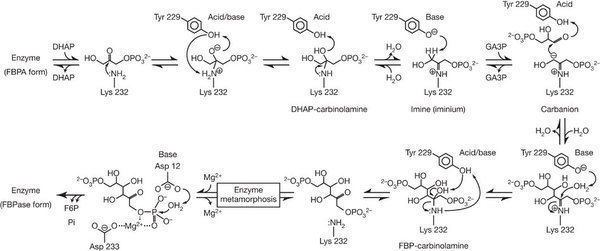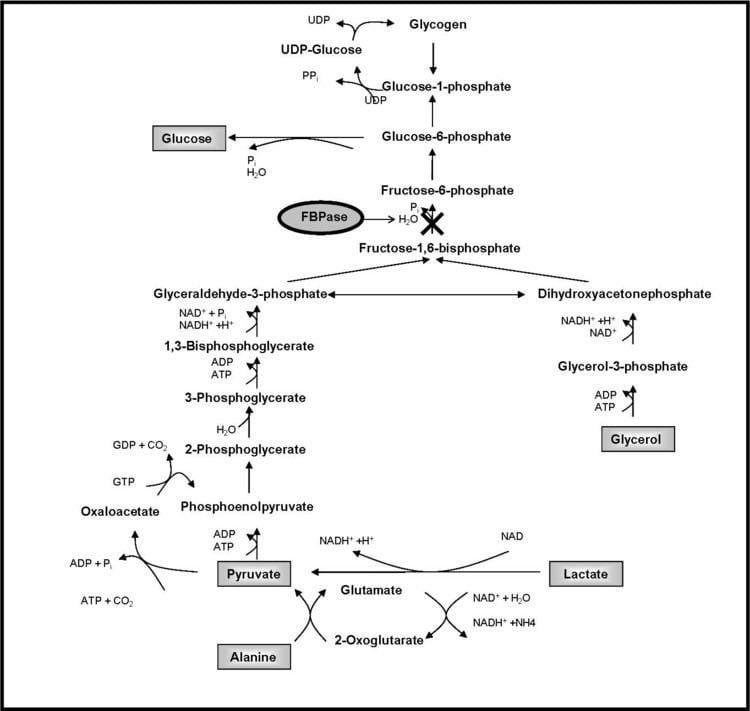Symbol FBP1 Entrez 2203 OMIM 229700 | Alt. symbols FBP HUGO 3606 RefSeq NM_000507 | |
 | ||
Fructose bisphosphatase (EC 3.1.3.11) is an enzyme that converts fructose-1,6-bisphosphate to fructose 6-phosphate in gluconeogenesis and the Calvin cycle which are both anabolic pathways. Fructose bisphosphatase catalyses the reverse of the reaction which is catalysed by phosphofructokinase in glycolysis. These enzymes only catalyse the reaction in one direction each, and are regulated by metabolites such as fructose 2,6-bisphosphate so that high activity of one of the two enzymes is accompanied by low activity of the other. More specifically, fructose 2,6-bisphosphate allosterically inhibits fructose 1,6-bisphosphatase, but activates phosphofructokinase-I. Fructose 1,6-bisphosphatase is involved in many different metabolic pathways and found in most organisms. FBPase requires metal ions for catalysis (Mg2+ and Mn2+ being preferred) and the enzyme is potently inhibited by Li+.
Contents
- Structure
- Species distribution
- Interactive pathway map
- Hibernation and Cold Adaptation
- Diabetes
- References

Structure
The fold of fructose-1,6-bisphosphatase from pig was noted to be identical to that of inositol-1-phosphatase (IMPase). Inositol polyphosphate 1-phosphatase (IPPase), IMPase and FBPase share a sequence motif (Asp-Pro-Ile/Leu-Asp-Gly/Ser-Thr/Ser) which has been shown to bind metal ions and participate in catalysis. This motif is also found in the distantly-related fungal, bacterial and yeast IMPase homologues. It has been suggested that these proteins define an ancient structurally conserved family involved in diverse metabolic pathways, including inositol signalling, gluconeogenesis, sulphate assimilation and possibly quinone metabolism.
Species distribution
Three different groups of FBPases have been identified in eukaryotes and bacteria (FBPase I-III). None of these groups have been found in archaea so far, though a new group of FBPases (FBPase IV) which also show inositol monophosphatase activity has recently been identified in archaea.
A new group of FBPases (FBPase V) is found in thermophilic archaea and the hyperthermophilic bacterium Aquifex aeolicus. The characterised members of this group show strict substrate specificity for FBP and are suggested to be the true FBPase in these organisms. A structural study suggests that FBPase V has a novel fold for a sugar phosphatase, forming a four-layer alpha-beta-beta-alpha sandwich, unlike the more usual five-layered alpha-beta-alpha-beta-alpha arrangement. The arrangement of the catalytic side chains and metal ligands was found to be consistent with the three-metal ion assisted catalysis mechanism proposed for other FBPases.
The fructose 1,6-bisphosphatases found within the Firmicutes (low GC Gram-positive bacteria) do not show any significant sequence similarity to the enzymes from other organisms. The Bacillus subtilis enzyme is inhibited by AMP, though this can be overcome by phosphoenolpyruvate, and is dependent on Mn(2+). Mutants lacking this enzyme are apparently still able to grow on gluconeogenic growth substrates such as malate and glycerol.
Interactive pathway map
Click on genes, proteins and metabolites below to link to respective articles.
Hibernation and Cold Adaptation
Fructose 1,6-bisphosphatase also plays a key role in hibernation, which requires strict regulation of metabolic processes to facilitate entry into hibernation, maintenance, arousal from hibernation, and adjustments to allow long-term dormancy. During hibernation, an animal’s metabolic rate may decrease to around 1/25 of its euthermic resting metabolic rate. Studies have found that FBPase is modified in hibernating animals to be much more temperature sensitive than it is in euthermic animals. In one study, FBPase in the liver of a hibernating bat showed a 75% decrease in Km for its substrate FBP at 5°C than at 37°C. However, in a euthermic bat this decrease was only 25%, demonstrating the difference in temperature sensitivity between hibernating and euthermic bats. When sensitivity to allosteric inhibitors such as AMP, ADP, inorganic phosphate, and fructose-2,6-bisphosphate were examined, FBPase from hibernating bats was much more sensitive to inhibitors at low temperature than in euthermic bats.
During hibernation, respiration also dramatically decreases, resulting in conditions of relative anoxia in the tissues. Anoxic conditions inhibit gluconeogenesis, and therefore FBPase, while stimulating glycolysis, and this is another reason for reduced FBPase activity in hibernating animals. The substrate of FBPase, fructose 1,6-bisphosphate, has also been shown to activate pyruvate kinase in glycolysis, linking increased glycolysis to decreased gluconeogenesis when FBPase activity is decreased during hibernation.
In addition to hibernation, there is evidence that FBPase activity varies significantly between warm and cold seasons even for animals that do not hibernate. In rabbits exposed to cold temperatures, FBPase activity decreased throughout the duration of cold exposure, increasing when temperatures became warmer again. The mechanism of this FBPase inhibition is thought to be digestion of FBPase by lysosomal proteases, which are released at higher levels during colder periods. Inhibition of FBPase through proteolytic digestion decreases gluconeogenesis relative to glycolysis during cold periods, similar to hibernation.
Fructose 1,6-bisphosphate aldolase is another temperature dependent enzyme that plays an important role in the regulation of glycolysis and gluconeogenesis during hibernation. Its main role is in glycolysis instead of gluconeogenesis, but its substrate is the same as FBPase’s, so its activity affects that of FBPase in gluconeogenesis. Aldolase shows similar changes in activity to FBPase at colder temperatures, such as an upward shift in optimum pH at colder temperatures. This adaptation allows enzymes such as FBPase and fructose-1,6-bisphosphate aldolase to track intracellular pH changes in hibernating animals and match their activity ranges to these shifts. Aldolase also complements the activity of FBPase in anoxic conditions (discussed above) by increasing glycolytic output while FBPase inhibition decreases gluconeogenesis activity.
Diabetes
Fructose 1,6-bisphosphatase is also a key player in treating type 2 diabetes. In this disease, hyperglycemia causes many serious problems, and treatments often focus on lowering blood sugar levels. Gluconeogenesis in the liver is a major cause of glucose overproduction in these patients, and so inhibition of gluconeogenesis is a reasonable way to treat type 2 diabetes. FBPase is a good enzyme to target in the gluconeogenesis pathway because it is rate-limiting and controls the incorporation of all three-carbon substrates into glucose but is not involved in glycogen breakdown and is removed from mitochondrial steps in the pathway. This means that altering its activity can have a large effect on gluconeogenesis while reducing the risk of hypoglycemia and other potential side effects from altering other enzymes in gluconeogenesis. In 1993, two East Asian plants that were known to have hypoglycemic effects were tested on rats. Both resulted in lowered levels of FBPase and therefore reduced gluconeogenesis and lowered blood sugar. Two years later, a drug called Troglitazone (shown below) that also targets FBPase was successfully tested on mice and resulted in suppressed gluconeogenesis. More recently, drugs been developed that mimic the inhibitory activity of AMP (shown below) on FBPase, though the first such drug caused dangerous side effects. Efforts were made to mimic the allosteric inhibitory effects of AMP while making the drug as structurally different from it as possible. Second-generation FBPase inhibitors have now been developed and have had good results in clinical trials with non-human mammals and now humans. These second-generation FBPase inhibitors could soon be good candidates for treating type 2 diabetes.
